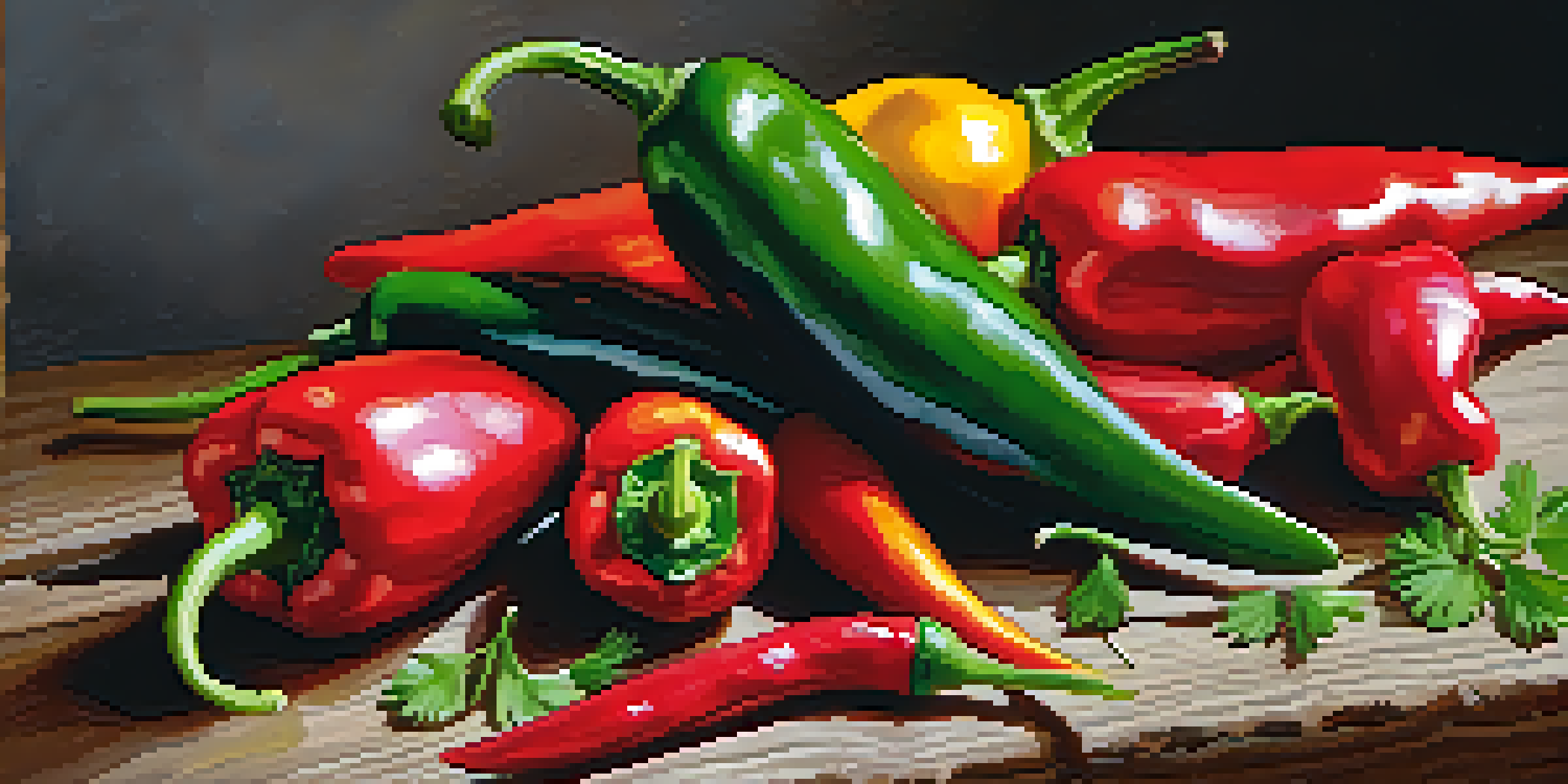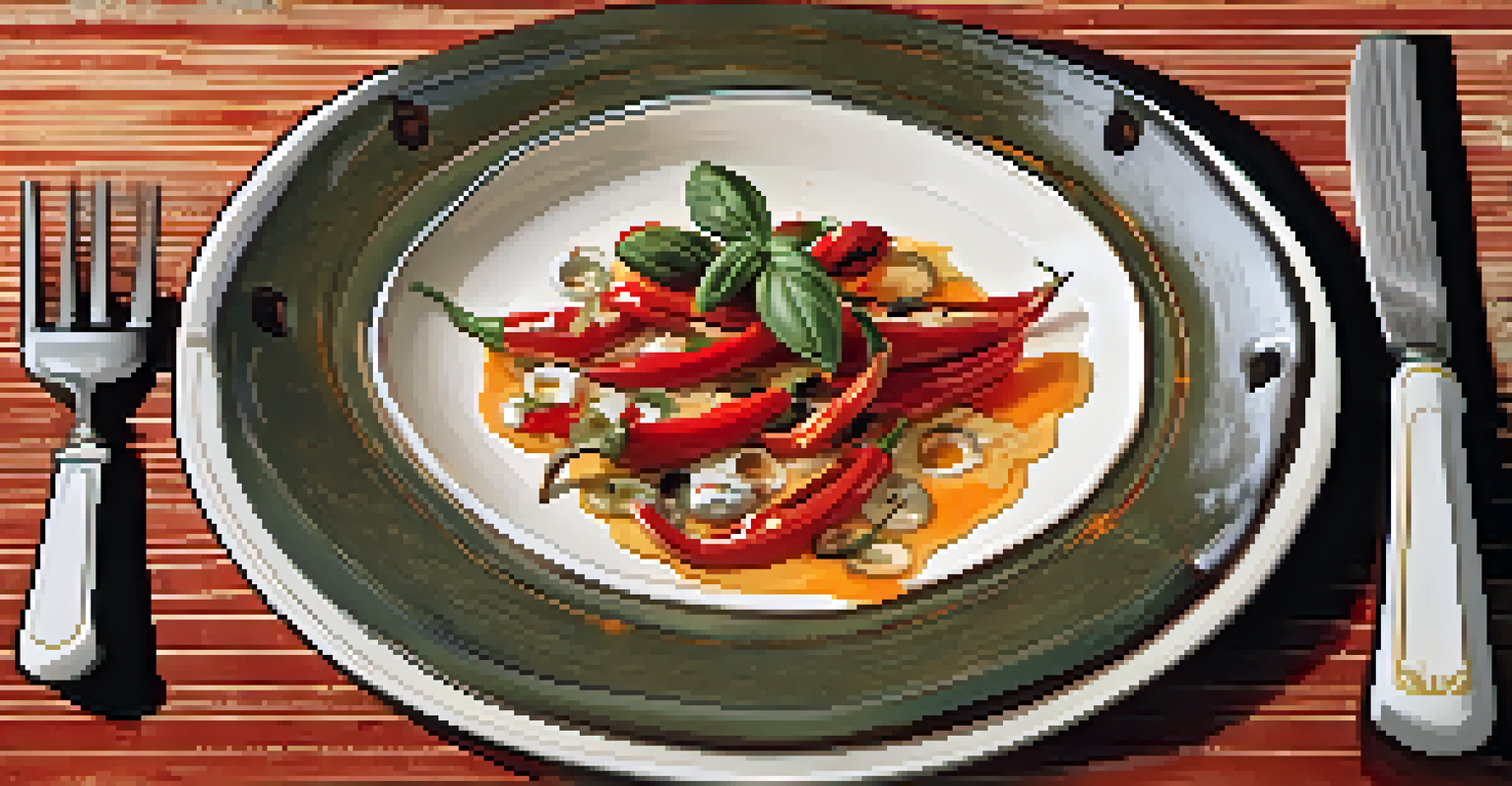Chili Peppers: Heat and Flavor in Spanish Cooking

The Importance of Chili Peppers in Spanish Cuisine
Chili peppers are vital to Spanish cooking, bringing both heat and depth to dishes. Their vibrant colors and varying flavors add not just spice, but also a distinct character to many recipes. From the mild Padrón peppers to the fiery cayenne, these ingredients are as diverse as the regions of Spain itself.
Chili peppers are the soul of Spanish cuisine, adding depth and character that transforms simple dishes into memorable culinary experiences.
In many traditional Spanish dishes, chili peppers can transform an ordinary meal into a culinary experience. They are often used in sauces, stews, and even as toppings, showcasing their versatility. The presence of these peppers exemplifies how flavor can be layered, enhancing the overall taste profile of a dish.
Moreover, chili peppers are not just about heat; they also contribute to the rich history of Spanish gastronomy. They have become integral to regional specialties, reflecting the local climate, culture, and agricultural practices. This connection with the land is what makes chili peppers a cornerstone of Spanish cooking.
Different Varieties of Chili Peppers in Spain
Spain is home to a wide variety of chili peppers, each with its own unique flavor and heat level. For example, the Padrón pepper is typically mild but can sometimes surprise you with a spicy kick. This unpredictability adds excitement to dishes and dining experiences.

Another popular variety is the Guindilla, a small green chili often used in tapas. Its bright flavor and moderate heat make it a favorite for enhancing dishes like patatas bravas or served alongside anchovies. Understanding these varieties can elevate your cooking and appreciation for Spanish cuisine.
Chili Peppers Enhance Spanish Dishes
Chili peppers elevate the flavors of traditional Spanish meals, adding depth and complexity to iconic recipes.
In contrast, the Ñora pepper, a dried variety, is essential for making authentic romesco sauce. Its sweet and smoky profile adds depth to many sauces and stews. By exploring these different types of chili peppers, cooks can unlock the full potential of Spanish flavors.
Chili Peppers in Traditional Spanish Dishes
Chili peppers play a starring role in many traditional Spanish dishes, enhancing their flavors significantly. Take paella, for example: the addition of smoked paprika, a spice made from dried and ground chili peppers, gives this iconic dish its signature flavor. Without it, paella would lack the depth and richness that makes it so beloved.
The beauty of cooking lies in the balance of flavors, and chili peppers bring that perfect kick that can elevate any meal.
Another classic dish, gazpacho, benefits from the inclusion of chili peppers, providing a refreshing heat that balances the coolness of the tomatoes and cucumbers. This combination exemplifies how chili peppers can complement other ingredients, creating a harmonious dish.
Additionally, chili peppers are often featured in Spanish tapas, where small plates showcase a variety of flavors. From spicy chorizo to roasted peppers drizzled with olive oil, these small bites celebrate the versatility and boldness of chili peppers in Spanish cooking.
The Health Benefits of Chili Peppers
Not only do chili peppers add flavor, but they also come packed with health benefits. Rich in vitamins A and C, they contribute to immune health and skin vitality. Including chili peppers in your diet can be a delicious way to nourish your body.
Moreover, the capsaicin found in chili peppers is known for its anti-inflammatory properties. It can help relieve pain and may even boost metabolism, making chili peppers a great addition to a balanced diet. So, enjoying that spicy salsa might just be doing your body good!
Health Benefits of Chili Peppers
Rich in vitamins and capsaicin, chili peppers offer numerous health benefits, including anti-inflammatory properties.
However, moderation is key; too much heat can lead to discomfort. By enjoying chili peppers in reasonable amounts, you can savor their flavor while reaping the health benefits they offer.
Pairing Chili Peppers with Other Ingredients
Pairing chili peppers with the right ingredients can enhance their flavors and create delightful culinary experiences. For instance, the sweetness of roasted red peppers beautifully balances their heat, making them perfect for salads or as a topping on toast. This interplay of flavors is what makes cooking so rewarding.
Cheeses, especially Spanish varieties like Manchego, also pair wonderfully with chili peppers. The creamy texture of cheese can soften the heat, allowing the flavors to meld together rather than compete. Experimenting with different combinations can lead to exciting new dishes.
Furthermore, incorporating fresh herbs like cilantro or parsley can brighten and elevate the dish. The freshness of herbs can offset the heat, making chili peppers more approachable for those who may be sensitive to spiciness.
Cooking Techniques for Using Chili Peppers
When it comes to cooking with chili peppers, the technique can greatly influence the outcome. For instance, roasting peppers can enhance their sweetness and smokiness, making them a fantastic addition to sauces or as a side dish. This simple method can significantly elevate the flavor profile of your dish.
Another technique is pickling, which not only preserves the peppers but also adds a tangy flavor that can brighten up many meals. Pickled chili peppers can be a zesty topping for tacos or sandwiches, providing that extra kick.
Diverse Varieties of Chili Peppers
Spain boasts a wide range of chili pepper varieties, each contributing unique flavors and heat levels to dishes.
Lastly, using fresh chili peppers in salsas or marinades allows for a burst of flavor that can transform any dish. Whether you prefer mild or hot varieties, incorporating them fresh can make your meals vibrant and exciting.
The Future of Chili Peppers in Spanish Cuisine
As culinary trends evolve, so does the use of chili peppers in Spanish cooking. Chefs are increasingly experimenting with new varieties and innovative techniques, pushing the boundaries of traditional recipes. This creativity keeps Spanish cuisine dynamic and ever-evolving.
Moreover, the growing interest in global flavors means that chili peppers are finding their way into unexpected dishes, blending different culinary traditions. This fusion can lead to exciting new flavors that honor the essence of Spanish cooking while embracing modern influences.

In this way, chili peppers will continue to be a staple ingredient, bridging the gap between tradition and innovation in the culinary world. Their ability to adapt and inspire will ensure they remain a key player in Spanish cuisine for years to come.